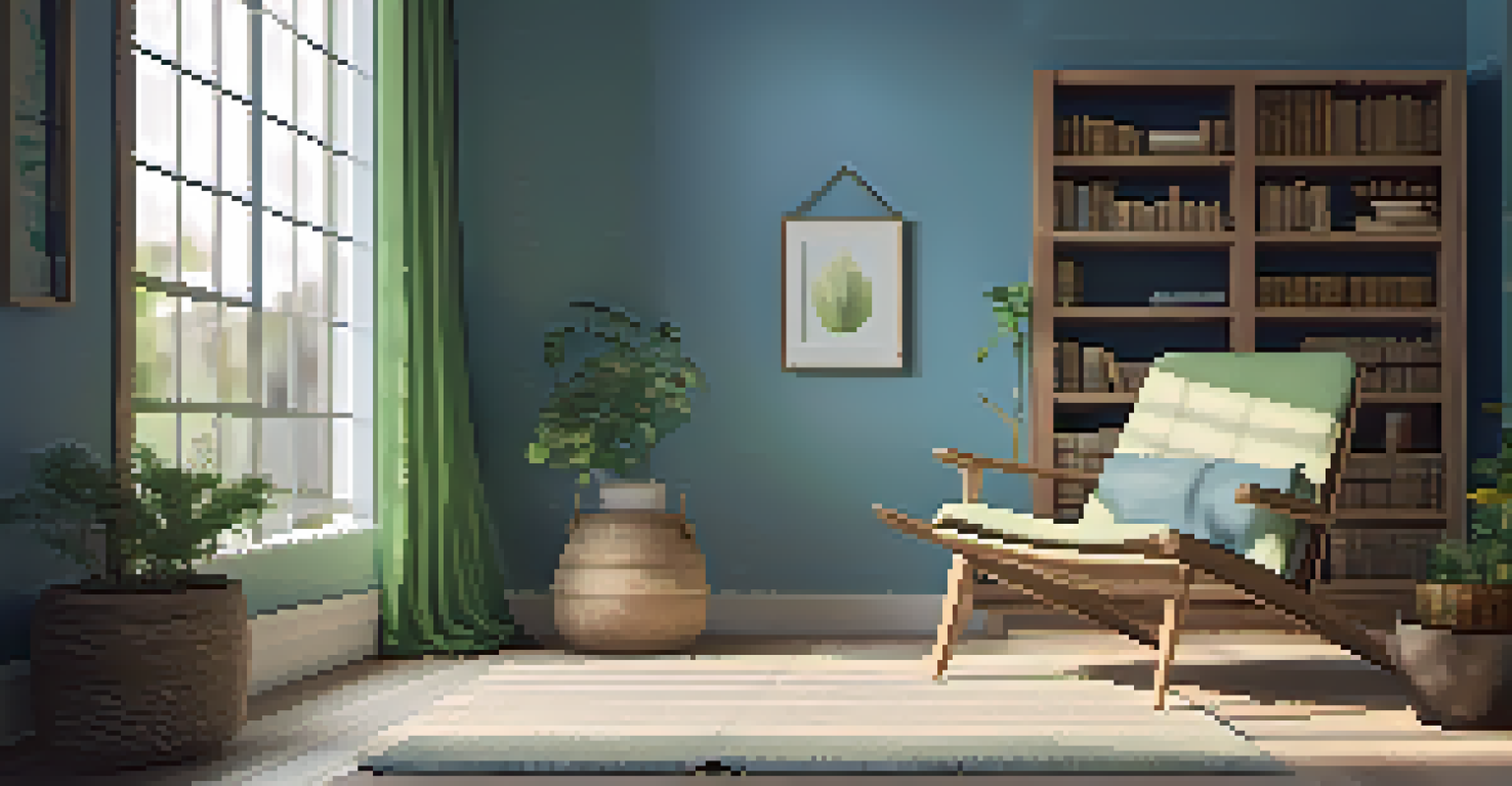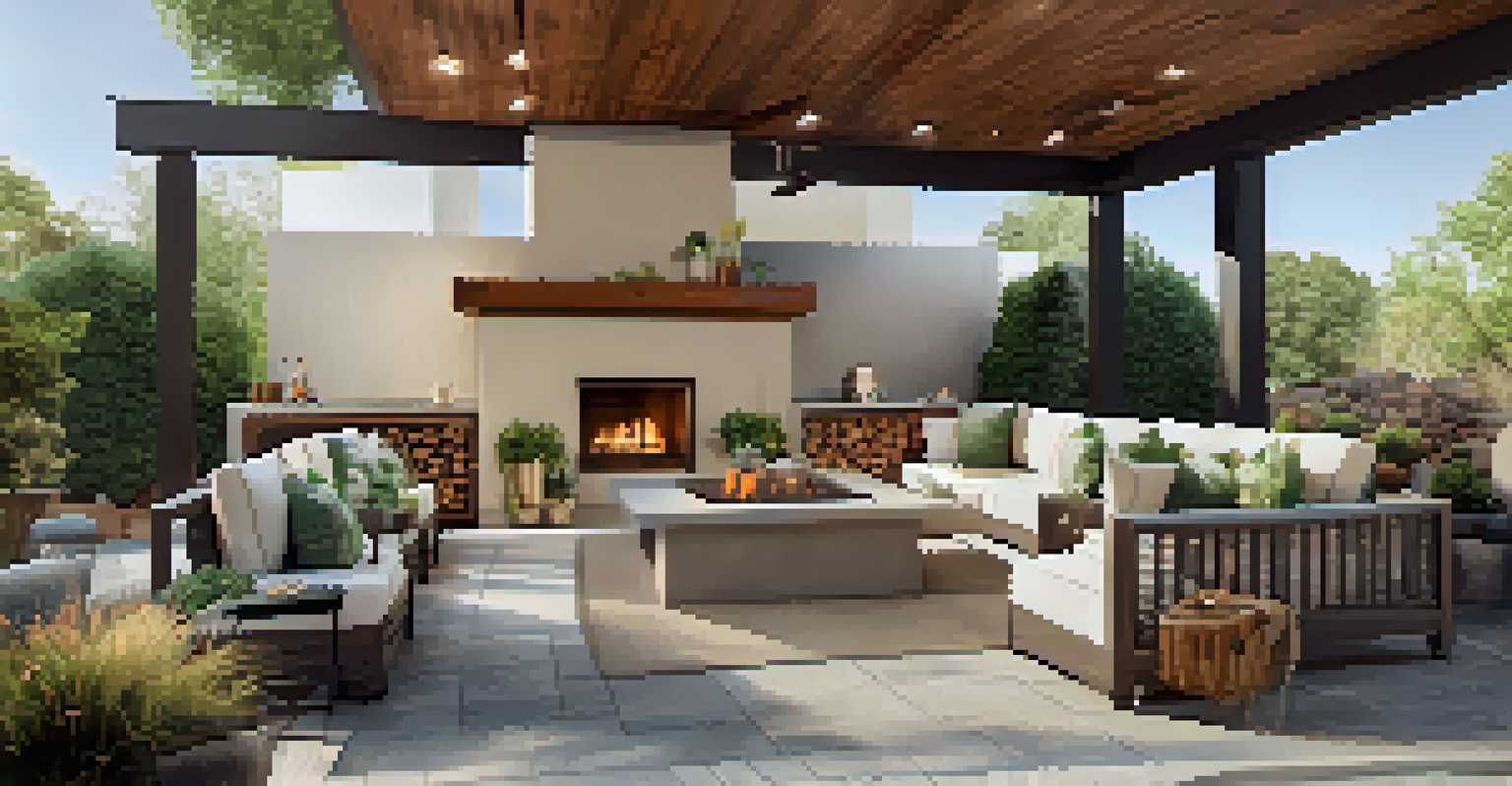Designing with Wellness in Mind: Future Home Trends

The Rise of Biophilic Design in Homes
Biophilic design connects us with nature, enhancing our well-being. By incorporating natural elements like plants and water features, homes become sanctuaries that promote relaxation and reduce stress. Imagine walking into a living room filled with greenery and natural light; it instantly elevates your mood and creates a calming atmosphere.
The clearest way into the Universe is through a forest wilderness.
This trend reflects our growing awareness of mental health and the importance of environments that support it. For example, homes with large windows and open spaces encourage a seamless flow between indoor and outdoor living. As more people recognize the benefits of nature on mental wellness, biophilic design is expected to dominate future home trends.
Moreover, biophilic elements can boost productivity and creativity, making them perfect for home offices. By integrating natural materials and designs, homeowners can create spaces that not only look beautiful but also foster emotional and psychological well-being.
Mindful Spaces for Mental Clarity
Creating mindful spaces is all about curating environments that promote mental clarity and calmness. Designating areas in your home for meditation or quiet reflection can significantly enhance your overall wellness. Think of a cozy nook with soft lighting, comfortable seating, and minimal distractions—this can be your personal retreat from the chaos of everyday life.

As we become more aware of the impact of our surroundings on our mind, the demand for intentional, clutter-free spaces continues to rise. Homes that prioritize simplicity and functionality help to reduce anxiety and overwhelm. Each piece of furniture and decor should serve a purpose, creating a harmonious balance that is both aesthetically pleasing and soothing.
Nature Enhances Home Wellness
Incorporating biophilic design elements like plants and natural light can significantly boost mental well-being and create calming spaces.
For instance, using soothing colors and natural textures can evoke a sense of peace. Incorporating soundproof materials also contributes to a tranquil atmosphere, allowing you to escape from the noise of the outside world and focus on your inner thoughts.
Sustainable Designs That Nurture Health
Sustainability is no longer just a buzzword; it’s an essential aspect of home design that prioritizes both environmental and personal health. Eco-friendly materials and energy-efficient systems contribute to a healthier living space by reducing harmful pollutants. For example, choosing non-toxic paint and sustainable flooring not only protects the environment but also ensures better indoor air quality.
Nature does not hurry, yet everything is accomplished.
This trend is gaining traction as homeowners become more conscious of their environmental impact and its effects on personal well-being. Sustainable homes often feature designs that maximize natural light and ventilation, which can significantly improve mood and overall health. Imagine waking up in a space that feels not only good for the planet but also rejuvenates your spirit.
Moreover, integrating renewable energy sources, such as solar panels, further enhances the wellness aspect of sustainable design. Not only do these features promote energy independence, but they also contribute to a sense of pride and responsibility towards preserving the earth for future generations.
Smart Technology for Healthier Living
Smart home technology is revolutionizing the way we think about wellness in our living spaces. From smart thermostats that maintain optimal temperatures to air purifiers that monitor air quality, technology plays a crucial role in creating healthier environments. Imagine having a system that adjusts lighting based on your mood or time of day—this is not just convenient; it enhances your overall well-being.
Moreover, health-focused apps can track your habits and remind you to take breaks, hydrate, or even practice mindfulness. As technology continues to evolve, we can expect even more innovative solutions that integrate wellness into our daily routines. For example, smart beds that monitor sleep patterns can help improve rest and recovery.
Sustainable Living for Health
Utilizing eco-friendly materials and energy-efficient systems in home design promotes not only environmental health but also personal wellness.
This seamless integration of technology into home design is making it easier than ever to prioritize health and wellness. As smart technology becomes more affordable and accessible, it will likely become a staple in future home trends, ensuring that well-being is at the forefront of our living spaces.
Flexible Spaces for Evolving Needs
In today’s fast-paced world, flexibility in home design is key to meeting our evolving needs. Homes that adapt to various lifestyles—whether it’s a quiet workspace, a family gathering area, or a fitness zone—are becoming increasingly popular. Think about the versatility of a room that can transform from a home office during the day to a cozy movie night spot in the evening.
As more people work from home, the demand for multifunctional spaces continues to grow. Homeowners are looking for designs that offer adaptability without compromising comfort or style. This trend embraces open floor plans and movable furniture, allowing residents to create environments that suit their daily activities.
For example, modular furniture can easily change configurations, providing both function and aesthetic appeal. This flexibility not only enhances the living experience but also promotes a sense of control and satisfaction, contributing to overall well-being.
Color Psychology in Home Design
Color plays a crucial role in how we feel within our homes, and understanding color psychology can enhance wellness. Different colors evoke different emotions; for instance, soft blues and greens can create a sense of calm, while warmer hues like yellow can boost energy and happiness. Choosing the right palette can transform a space from merely functional to emotionally uplifting.
As homeowners become more aware of the impact colors have on mood, the trend is shifting towards intentional color choices in design. For example, a serene bedroom painted in cool tones can promote restful sleep, while an inspiring home office adorned with bright colors can stimulate creativity and productivity. Imagine how a well-thought-out color scheme can shape your daily experiences.
Smart Tech Boosts Comfort and Health
Integrating smart home technology helps create healthier living environments by controlling various factors that impact well-being.
This trend is not just about aesthetics; it’s about creating environments that support mental health. By thoughtfully selecting colors that resonate with your personal style and emotional needs, you can create a home that feels like a true reflection of yourself and a sanctuary for your well-being.
Outdoor Living Spaces for Connection
Outdoor living spaces are becoming essential extensions of our homes, promoting wellness through connection with nature and community. These areas are designed for relaxation, social gatherings, or simply enjoying the fresh air, which can significantly enhance our quality of life. Picture a beautifully designed patio with comfortable seating, surrounded by lush greenery—a perfect spot for unwinding after a long day.
As people prioritize outdoor spaces, trends are leaning towards creating functional areas that blend seamlessly with indoor living. Features like outdoor kitchens, fire pits, and cozy lounges encourage families and friends to gather, fostering connections that are vital for mental health. The act of sharing meals or enjoying a sunset together can elevate our sense of belonging and joy.

Additionally, outdoor spaces provide opportunities for physical activity and mindfulness, whether it’s practicing yoga on a deck or gardening. By incorporating these elements into home design, homeowners can create vibrant environments that nurture both physical and emotional wellness.